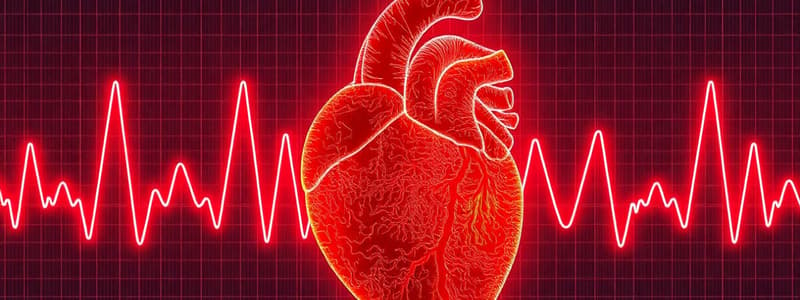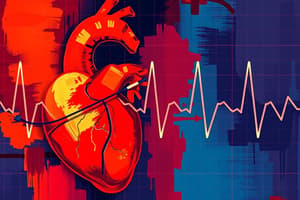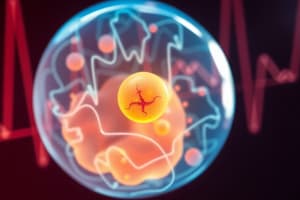Podcast
Questions and Answers
What is the primary use of antidysrhythmic drugs?
What is the primary use of antidysrhythmic drugs?
- To treat and prevent disturbances in cardiac rhythm. (correct)
- To increase blood pressure.
- To prevent strokes.
- To lower cholesterol levels.
In a resting cardiac cell, what is the net charge inside the cell relative to the outside?
In a resting cardiac cell, what is the net charge inside the cell relative to the outside?
- Net positive charge
- Neutral charge
- Net negative charge (correct)
- Variable charge depending on ion concentration
What maintains the electronegative charge difference across the cell membrane of a cardiac cell?
What maintains the electronegative charge difference across the cell membrane of a cardiac cell?
- The Sodium-Potassium ATPase pump. (correct)
- The diffusion of chloride ions.
- The presence of calcium channels.
- The movement of sodium ions.
Which of the following best describes the role of ion movement in cardiac cell excitation?
Which of the following best describes the role of ion movement in cardiac cell excitation?
What defines dysrhythmia in a cardiac context?
What defines dysrhythmia in a cardiac context?
Which of the following is the natural pacemaker of the heart?
Which of the following is the natural pacemaker of the heart?
What does the P wave represent on an electrocardiogram (ECG)?
What does the P wave represent on an electrocardiogram (ECG)?
What is the PR interval in an ECG?
What is the PR interval in an ECG?
What is the QRS complex?
What is the QRS complex?
Which of the following best describes what the 'T wave' represents in an ECG reading?
Which of the following best describes what the 'T wave' represents in an ECG reading?
What is the mechanism of action for Class Ia antidysrhythmic drugs?
What is the mechanism of action for Class Ia antidysrhythmic drugs?
Which electrolyte level is of particular importance to measure before initiating antidysrhythmic therapy?
Which electrolyte level is of particular importance to measure before initiating antidysrhythmic therapy?
Which of the following is a key nursing action when administering IV beta-blockers for dysrhythmias?
Which of the following is a key nursing action when administering IV beta-blockers for dysrhythmias?
What is a common adverse effect patients should be taught to monitor for when taking antidysrhythmic medications?
What is a common adverse effect patients should be taught to monitor for when taking antidysrhythmic medications?
Class Ib sodium channel blockers such as lidocaine primarily work by:
Class Ib sodium channel blockers such as lidocaine primarily work by:
Which of the following instructions should be given to a patient taking oral sustained-release antidysrhythmic medications?
Which of the following instructions should be given to a patient taking oral sustained-release antidysrhythmic medications?
What is a significant consideration when administering adenosine?
What is a significant consideration when administering adenosine?
A patient with a history of asthma is prescribed a beta-blocker for a heart condition. What is an important consideration?
A patient with a history of asthma is prescribed a beta-blocker for a heart condition. What is an important consideration?
Why is ventricular tachycardia a more serious dysrhythmia than atrial flutter?
Why is ventricular tachycardia a more serious dysrhythmia than atrial flutter?
Digoxin slows conduction between the SA & AV node, and has a high risk for toxicity. Which electrolyte imbalance would predispose a patient to digoxin toxicity?
Digoxin slows conduction between the SA & AV node, and has a high risk for toxicity. Which electrolyte imbalance would predispose a patient to digoxin toxicity?
How does amiodarone, a Class III antidysrhythmic, affect the cardiac action potential?
How does amiodarone, a Class III antidysrhythmic, affect the cardiac action potential?
What is the underlying mechanism behind the effectiveness of adenosine in treating paroxysmal supraventricular tachycardia (PSVT)?
What is the underlying mechanism behind the effectiveness of adenosine in treating paroxysmal supraventricular tachycardia (PSVT)?
How do sodium channel blockers work to suppress dysrhythmias?
How do sodium channel blockers work to suppress dysrhythmias?
A patient taking amiodarone develops a persistent dry cough and shortness of breath. Which of the following is the most appropriate nursing intervention?
A patient taking amiodarone develops a persistent dry cough and shortness of breath. Which of the following is the most appropriate nursing intervention?
A patient is prescribed digoxin for atrial fibrillation and reports seeing yellow halos around lights. What is the priority nursing action?
A patient is prescribed digoxin for atrial fibrillation and reports seeing yellow halos around lights. What is the priority nursing action?
A patient is started on amiodarone for recurrent ventricular tachycardia. What baseline assessments are most critical for the nurse to obtain?
A patient is started on amiodarone for recurrent ventricular tachycardia. What baseline assessments are most critical for the nurse to obtain?
A patient with heart failure who is taking digoxin is prescribed furosemide. The patient develops muscle weakness and an irregular heart rate. Which lab value should the nurse check first?
A patient with heart failure who is taking digoxin is prescribed furosemide. The patient develops muscle weakness and an irregular heart rate. Which lab value should the nurse check first?
A physician orders a continuous infusion of lidocaine for a patient experiencing frequent premature ventricular contractions (PVCs). Which of the following assessment findings would warrant immediate discontinuation of the lidocaine infusion?
A physician orders a continuous infusion of lidocaine for a patient experiencing frequent premature ventricular contractions (PVCs). Which of the following assessment findings would warrant immediate discontinuation of the lidocaine infusion?
A cardiologist is considering prescribing sotalol to a woman with paroxysmal atrial fibrillation for whom other treatments have failed. Which of the following pre-existing conditions would be of greatest concern when considering the use of this medication?
A cardiologist is considering prescribing sotalol to a woman with paroxysmal atrial fibrillation for whom other treatments have failed. Which of the following pre-existing conditions would be of greatest concern when considering the use of this medication?
Flashcards
Dysrhythmia
Dysrhythmia
Deviation from the normal heart rhythm.
Antidysrhythmics
Antidysrhythmics
Used to treat and prevent disturbances in cardiac rhythm.
Action Potential
Action Potential
When a change in ion distribution causes cardiac cells to become excited.
Cardiac Cell Excitation
Cardiac Cell Excitation
Signup and view all the flashcards
Resting Cardiac Cell Charge
Resting Cardiac Cell Charge
Signup and view all the flashcards
SA node
SA node
Signup and view all the flashcards
Electrocardiography (ECG)
Electrocardiography (ECG)
Signup and view all the flashcards
P Wave
P Wave
Signup and view all the flashcards
QRS Complex
QRS Complex
Signup and view all the flashcards
T wave
T wave
Signup and view all the flashcards
Supraventricular Tachycardia
Supraventricular Tachycardia
Signup and view all the flashcards
Atrial Fibrillation
Atrial Fibrillation
Signup and view all the flashcards
Atrial Flutter
Atrial Flutter
Signup and view all the flashcards
Inotropic
Inotropic
Signup and view all the flashcards
Chronotropic
Chronotropic
Signup and view all the flashcards
Dromotropic
Dromotropic
Signup and view all the flashcards
Vaughan Williams Classification
Vaughan Williams Classification
Signup and view all the flashcards
Class IA Antiarrhythmics
Class IA Antiarrhythmics
Signup and view all the flashcards
Class IB Antiarrhythmics Contraindications
Class IB Antiarrhythmics Contraindications
Signup and view all the flashcards
Class Ic Contraindications
Class Ic Contraindications
Signup and view all the flashcards
Class II: Beta Blocker
Class II: Beta Blocker
Signup and view all the flashcards
Class III: Potassium Channel Blockers action
Class III: Potassium Channel Blockers action
Signup and view all the flashcards
Class IV: Calcium Channel Blockers
Class IV: Calcium Channel Blockers
Signup and view all the flashcards
Digoxin (Lanoxin)
Digoxin (Lanoxin)
Signup and view all the flashcards
Adenosine (Adenocard)
Adenosine (Adenocard)
Signup and view all the flashcards
Antidysrhythmics: Nursing Implications.
Antidysrhythmics: Nursing Implications.
Signup and view all the flashcards
Antidysrhythmics: Potassium Implications.
Antidysrhythmics: Potassium Implications.
Signup and view all the flashcards
Monitor during therapy
Monitor during therapy
Signup and view all the flashcards
Antidysrhythmics: Teaching Moment.
Antidysrhythmics: Teaching Moment.
Signup and view all the flashcards
Follow worsening symptoms
Follow worsening symptoms
Signup and view all the flashcards
Study Notes
- Dysrhythmia is any heart deviation from the normal rhythm.
- Antidysrhythmics are used for the treatment and prevention of disturbances in cardiac rhythm.
- A change in the distribution of ions causes cardiac cells to become excited.
- Movement of ions across the cell's membrane results in an electrical impulse spreading across the cardiac cells.
- This electrical impulse leads to contraction of the myocardial muscle.
- Resting cardiac cells have a net negative charge relative to the outside of the cell.
- A difference in electronegative charge results from an uneven distribution of ions across the cell membrane, which is maintained by the Sodium-Potassium ATPase pump
- The sinoatrial (SA) node is the natural pacemaker of the heart and has an inherent rate of 60-100 BPM
Electrocardiography
- ECG or EKG
- P wave represents electricity to atria
- PR interval represents electricity to atria
- QRS complex represents contraction and electricity to ventricles
- ST segment
- T wave
Common Atrial Dysrhythmias
- Supraventricular Tachycardia. The PR interval is too small / ineligible to see
- Atrial Fibrillation has no P waves
- Atrial Flutter shows a predictable pattern
Ventricular Dysrhythmias
- Ventricular Tachycardia
- Ventricular Fibrillation
Antidysrhythmic Drugs Mechanisms of Action
- Prolong the AV node
- Increase or reduce conduction speed
- Alter ectopic pacemakers and SA node
- Reduces myocardial excitability
- Stimulates the autonomic nervous system
Pharmacodynamics
- Inotropic: force of contraction (increase or decrease)
- Chronotropic: rate of contractions
- Dromotropic: electrical current
Vaughan Williams Classification of Antidysrhythmic Drugs
- Class I: Sodium Channel Blocker (Ia, Ib, Ic)
- Class II: Beta Blocker
- Class III: Potassium Channel Blocker
- Class IV: Calcium Channel Blocker
- Other antidysrhythmics include digoxin and adenosine
Drugs Affecting the Cardiac Action Potential
- Class 1 agents block Na+ channels
- Class 2 agents are B-blockers
- Class 3 agents block K+ channels
- Class 4 agents block Ca2+ channels
Class Ia Sodium Channel Blockers:
- Procainamide (Proneystl), Quinidine gluconate, disopyramide (Norpace)
- They block sodium (fast) channels and delay repolarization
- Used for atrial fibrillation, flutter, ventricular of ventricular tachycardia, supraventricular tachycardia and Wolff-Parkinson-White Syndrome
- Adverse effects include Systemic Lupus Syndrome, cardiotoxicity and hypotension
- are contraindicated for liver or renal disorders, and pregnancy risk category C medications
- Food interactions include with antidysrhythmics and antihypertensives
- Do not crush or chew sustained-release medications
Class Ib Sodium Channel Blockers:
- Lidocaine(Xylocaine), mexiletine (Mexitil), tocainide (Tonocard)
- They decrease electrical conduction and increase the rate of repolarization
- Used for Ventricular Dysrhythmias
- Adverse effects are CNS-related, (twitching, convulsions, respiratory depression)
- Liver and renal dysfunction may be a contraindication
- IV administration is weight-based and then a maintenance dose
Class Ic Sodium Channel Blockers:
- Propafenone (Rhythmol), flecainide (Tambocor)
- Decrease electrical conduction and excitability but increase the rate of repolarization
- Used for Supraventricular Tachycardia
- Contraindications: Severe heart failure and Severe hypotension
- Monitor patient's ECG, for bradycardia and hypotension
- Take medication with food and do not crush
Class II Beta Blockers:
- Propranolol hydrochloride (Inderal), esmolol hydrochloride (Brevibloc), metoprolol (Lopressor)
- Action: Prevents sympathetic nervous system stimulation of the heart, decreasing heart rate, and slows rate of conduction through the SA node
- Used for Atrial fibrillation, Atrial flutter, SVT
- Adverse Effects: Bradycardia, hypotension, impotence
- Contraindications: Severe asthma/ heart failure (Short-acting inhaler does not have receptor sites)
- Mask the hypoglycemic effect of insulin
- Nursing Administration: Take apical pulse daily and administer IV form slowly
Class III Potassium Channel Blockers:
- Amiodarone (Cordarone, Pacerone), sotalol (Betapace), dofetilide (Tikosyn)
- Prolong the action potential and refractory period of the cardiac cycle by decreasing the rate of repolarization, electrical conduction, and contractility
- Used for Atrial Fibrillation, recurrent ventricular fibrillation, ventricular tachycardia
- Contraindications: AV block, bradycardia, liver, thyroid or respiratory dysfunction
- Caution with Diltiazem, digoxin, and warfarin
- Amiodarone is highly toxic and can cause pulmonary fibrosis
Class IV Calcium Channel Blockers:
- Verapamil (Calan), diltiazem (Cardizem)
- Decreases myocardial oxygen demand, force of contraction, heart rate and rate of conduction through SA and AV nodes and also decreases depolarization of muscles
- Used for Atrial Fibrillation /Flutter and SVT
- Adverse Effects include bradycardia, hypotension, constipation
- Contraindications: SA/AV dysfunction and Heart blocks
- May cause orthostatic hypotension so change positions slowly and notify health provider if peripheral edema or shortness of breath
Other Antidysrhythmics
Digoxin (Lanoxin)
- For Advanced heart failure
- Slows conduction between the SA & AV node an so is used to slow the rate in atrial fibrillation and flutter
- Administer PO or IV
- Follow Digoxin levels due to high risk for toxicity and/or potential for renal impairment
- Cardiac arrhythmias and yellow halos are adverse effects
Adenosine (Adenocard)
- Corrects only AV node problems
- Slows condition through the AV node
- Used to convert paroxysmal supraventricular tachycardia to sinus rhythm
- Very short half-life so must administer as a fast IV push
- May cause asystole for a few seconds
Nursing Implications Regarding Antidysrhythmics
- Obtain a thorough drug and medical history
- Measure baseline BP/P, I & O, and cardiac rhythm
- Measure serum potassium levels before initiating therapy
- During therapy, monitor cardiac rhythm, heart rate, BP, general well-being, skin color, temperature, heart and lung sounds
- Assess plasma drug levels as indicated
- Monitor for toxic side effects
- Instruct patients to take medications as scheduled and not to skip doses or double up for missed doses
- Instruct patients to contact their physician for instructions if a dose is missed
- Instruct patients not to crush or chew oral sustained-release preparations
- Administer IV infusions with an IV pump
- Teach patients taking beta-blockers, digoxin, and other drugs how to take their own radial pulse for 1 full minute, and to notify their physician if the pulse is less than 60 beats/minute before taking the next dose
- Ensure the patient knows to notify health care provider of any worsening of dysrhythmia or toxic effects.
- Shortness of breath
- Edema
- Dizziness
- Syncope
- Chest pain
- Gl distress
- Blurred Vision
- Changes in cardiac output
Expected outcomes from Antidysrhythmic treatment
- Decreased BP in hypertensive patients
- Decreased edema
- Decreased fatigue
- Regular pulse rate with no major irregularities
- Improved regularity of rhythm
- Improved cardiac output
SDOH
- Older adults with HTN, heart failure, diabetes and thyroid disease are more at risk of developing dysrhythmias
- Lidocaine - $5 for 20 doses
- Propranolol – 30 day supply $30-$80
- Digoxin - $50 for 100 tablets
Studying That Suits You
Use AI to generate personalized quizzes and flashcards to suit your learning preferences.




